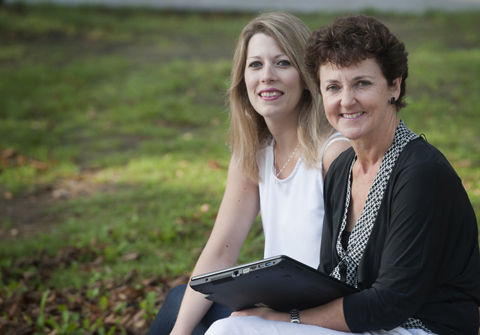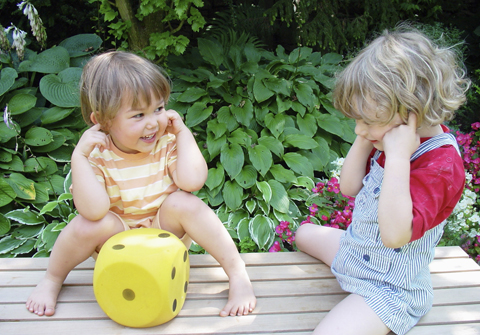Children learn quantifiers in the same order no matter what their language is
The study in which researchers of the UPV/EHU-University of the Basque Country have participated has been published in the PNAS journal
First publication date: 13/09/2016

We can assume that children learn to count starting with one and followed by the lists of numbers in ascending order of cardinality (one, two, three). But besides numbers, in languages there are more words that express quantity such as all, some, most, none, etc., the so-called quantifiers. It is a little more difficult imagining how children learn these expressions, whose meaning and use no one bothers to teach explicitly. A recent study into childhood language in 31 languages, in which UPV/EHU researchers have participated, has reached the surprising conclusion that in all the languages studied, children acquire the quantifiers in the same order, irrespective of the properties of the language in question.
This result brings a new perspective to the debate on the universality of language, since the fact that languages with different properties on a specific level are acquired or learnt in a similar way confirms the existence of universal patterns in the language acquisition process that do not always coincide with the linguistic universals, according to which the world's languages are classified. The recent research also signifies a first step in the creation of language assessment tests that can be applied to any language.
To sum this up considerably, the recent study has discovered that children acquire the words denoting quantity, such as the English words some and all, in a predictable order in languages with very different properties. Just as previous studies suggest that children learn numbers in ascending order, first uno, then dos and later on tres in Spanish or bat, bi, hiru in Basque, this new study set out to determine the order in which children acquire a set of quantifiers.
The study analyses the data on the comprehension of the quantifiers none, some, all, most by 768 five-year-old children and 536 adults. Among the 31 languages grouped into 11 language families, the data pertaining to Basque, the only language in its group, and of Spanish belonging to the Romance languages, are also included. The procedure consisted of presenting the participants with pictures showing a series of images in which there were always five boxes and five objects (five apples, five cars, etc.) of which zero, only three or all five appeared placed inside the boxes. Together with each picture the participant heard a sentence containing a quantifier (e.g. all the apples are in the boxes, some applies are in the boxes, etc.) and they were asked to say whether in each case the sentence describing the picture was correct. The researchers confirmed that across the languages studied the children identified the quantifiers all or none more easily than some or most. This suggests that children acquire quantifiers in the same order basing themselves on factors relating to the meaning and use of each quantifier. So they acquire the words referring to totality earlier than the ones covering only one part of the set.
About the researchers
Maria José Ezeizabarrena-Segurola and Tania Barberán-Recalde, tenured lecturer and PhD student, respectively, in the Department of Linguistics and Basque Studies of the University of the Basque Country (UPV/EHU) participated alongside another 50 collaborators in this international project led by Napoleon Katsos of Cambridge University. The study was published on 1 August, 2016, in the online edition of the prestigious journal Proceedings of the National Academy of Sciences(PNAS). Most of the researchers collaborated in the European Research Network COST Action A33 "Cross-Linguistically Robust Stages of Children's Linguistic Performance" (2006–2010). Dr Ezeizabarrena's team were responsible for gathering and analysing the data on childhood Basque and Spanish for which funding from various public institutions was crucial: the UPV/EHU and the Government of the Basque Autonomous Community (IT-676-13 and GIC 12/170), the Spanish Ministry of the Economy and Competitiveness (FFI2012-37884-C03-02), and the Government of Navarre (the pre-doctoral grant of Tania Barberán).
Bibliographical reference
Katsos, N.; Cummins, K.; Ezeizabarrena, M.J.; Gavarró, A.; Kuvač Kraljević, J.; Hrzica, G.; Hrzica, G.; Grohman, Kl.; Skordi, A.; Jensen de López, K.; Sundahl, L.; van Hout, A.; Hollebarandse, B.; Overwegi J.; Faberi, M.; van Koert, M.; Smith, N.; Vijam,M.; Zupping, S.; Kunnari, S.; Morisseau, T.; Rusieshvili, M.; Yatsushiro, K.; Fengler, A.; Varlokosta, S.; Konstantzous, K.; Farby, Sh.; Guasti, M.T.; Vernice, M.; Okabe, R.; Isobe, M; Crosthwaite, P.; Hongy, Y.; Balčiūnienė, I.; , Ahmad Nizar, Y.M.; Grech, H.; Gatt, D.; Cheong, W.N.; Asbjørnsenγ, A.; von Koss Torkildsen, J.; Haman, E.; Miękisz, A.; Gagarina, N.; Puzanova, J.; Anđelković, D.; Savić, M.; Jošić, Sm.; Slančová, D.; Kapalková, Sv.; Barberán, T.; Özge, D.; Hassan, S.; Hung Chan, Y.; Okubo, T.; van der Lely, H.†; Sauerland, U. & Noveck, I (2016), 'Cross-linguistic patterns in the acquisition of quantifiers', Proceedings of the National Academy of Sciences (PNAS), doi:10.1073/pnas.1601341113.



